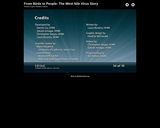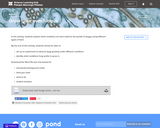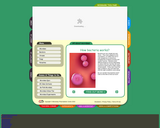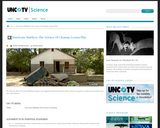
Students research and summarize the key features of bacteria, viruses, and fungi.
- Subject:
- Science
- Material Type:
- Lesson Plan
- Provider:
- Science Learning Hub
- Date Added:
- 03/07/2018

Students research and summarize the key features of bacteria, viruses, and fungi.

This "Click and Learn" presents how West Nile virus infects mosquitoes, birds, and people - with very different consequences.

This lesson will provide students with knowledge on the various types of pathogens that may invade a human or animal's body and the route that such pathogens taken in order to cause an infection. Students will create a narrative written in first person where they will act as if they are a pathogen (bacterial, viral etc.) and explain how they enter the body, what organ systems they affect, and how they ultimately cause infection in the body.

In this lesson, students learn about the characteristics of fungi.

This laboratory exercise includes both a lecture on the purpose of practicing aseptic technique as well as an explanation of how to practice aseptic techniques. Students will actually practice aseptic technique by plating bacteria in order to isolate individual colonies of bacteria. In addition, students will hypothesize which fomites they believe will have the most bacterial contamination and take swabs of their fomites to check for bacteria.

This Science Update looks at the lifespan of cold and flu viruses. Supplemental resources, including a background essay and discussion questions, are also provided.

In this lesson, students will determine the agent and the source of the agent causing a hypothetical outbreak of diarrheal illness. The activity is modeled after the 1993 outbreak of Cryptosporidium infections that involved a public water system in Milwaukee. It provides opportunities for students to use analytical thinking skills to determine the cause of the outbreak.

This lesson plan specifically addresses the implications of a natural disaster and its effects on water quality and a community's health. Students will learn methods used during an emergency response to test and treat water that has been contaminated by pathogenic microorganisms. Water treatment options introduced can vary depending on the location and type of emergency involved, but have the same goal to reduce human illness and death. After completing this lesson, students will have an improved understanding of which organizations are involved in emergency response and why safe drinking water is a substantial heath concern after a natural disaster.

Students explore what conditions are best suited to the growth of fungus using different types of food.

This video lesson explains how smart advances in vaccine design, production and distribution are bringing us closer than ever to eliminating a host of global threats -- from AIDS to malaria to flu pandemics. Assessment and discussion questions, as well as links to additional resources, are included.

In this lesson, students will take part in a scientific investigation of a 1993 hantavirus outbreak and learn how to prevent hantavirus infection.

Students learn an introduction to bacteria and how it works.

The biggest challenge in a parasite's life is to move from one host to another. Intriguingly, many parasites have evolved the ability to manipulate the behavior of their hosts to improve their own survival -- sometimes even by direct brain control. This video details a few parasites that can really mess with the mind.

This short video lesson explores the question of why some germs are relatively harmless while others can be fatal, by examining germs' varying modes of transmission. Assessment and discussion questions, as well as links to additional resources, are included.

This short video lesson examines the process of how vaccines work. Assessment and discussion questions, as well as links to additional resources, are included.

Students will describe the circumstances under which mold grows most quickly, especially as related to the aftermath of storms. Students will also summarize the basic characteristics of bacteria and fungi relating to the spread of diseases.

This presentation is a supplemental resource to be used in conjunction with the lesson "I Have a Gut Feeling." This lesson plan demonstrates how surveillance can be used by epidemiologists to identify and define an outbreak or public health problem. Students will gain a basic understanding of public health surveillance terminology, systems, and applications. They also will have an opportunity to apply their knowledge in analyzing data from a case study of an outbreak of Escherichia coli infections. At the end of the lesson, students should have a stronger understanding of public health surveillance and its application in monitoring and ending outbreaks.

In this lesson, students will use evidence to determine whether a patient has a cold, flu, or strep infection. In the process, they will also learn about the differences between viral and bacterial infections.

This brief video clip discusses the causes, spread, treatment, and prevention strategies for cholera and dengue fever. The connection between climate change and increased global temperatures and increased outbreaks of infectious diseases is also discussed.

In this lesson, students are engaged in a demonstration of how germs are transmitted from person to person and also involved in an inquiry-based activity where they will observe bacterial growth. With these activities, they will determine the abundance and types of microbes that are found around them.